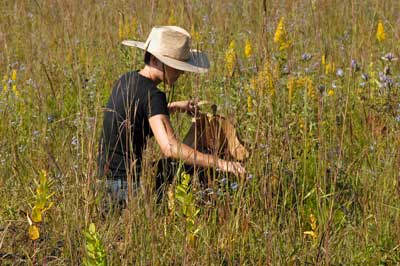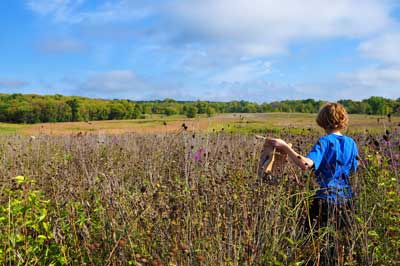
Volunteers collect seeds and help restore park prairies
Today, only 1% of prairie land that once existed in North America remains. Each fall, staff and volunteers in the Twin Cities metro area’s regional parks system work together to restore prairie land. From August through October each year, individuals and groups are invited to explore these protected lands and collect seeds from 65 to 75 different plant and flower species.
Parks staff clean, sort, and store the largely volunteer-harvested seeds until it’s time to plant. This community effort connects people to the land and helps save park resources. If parks had to purchase native seeds to keep the prairies thriving it would cost each of them tens of thousands of dollars.
“If people are interested in visiting a restored prairie, the rarest landscape in Minnesota, there are amazing opportunities throughout the regional parks system — from Bunker Hills Regional Park in Anoka County all the way down to Spring Lake Park Reserve in Dakota County,” said Emmett Mullin, senior manager of regional parks for the Metropolitan Council.
Prairies support diverse plant and animal species
170 million acres of prairie land once stretched from southern Wisconsin to western Montana and from central Texas to Canada until 1862, when the Homestead Act accelerated the tearing up of the prairie for farming by European settlers. These vast ecosystems supported a diverse landscape of tall grasses and fragrant wildflowers and were once abundant with pollinators and home to diverse wildlife, including millions of bison.
Native American tribes lived harmoniously with the prairie and saw the value of responsible land stewardship. Their relationship with the land was symbiotic and spiritual, rich with rituals deeply rooted in place. “The prairie offered an abundance of native plants used for medicine and sometimes as a food source,” said Dan McSwain, parks natural resource coordinator of Washington County.
Prairies depended on large animals to graze the land, to work the soil, and spread seed. Today, regional parks rely heavily on volunteers to play this role, trampling the land and disturbing seed pods, while collecting seeds, like the way a bison herd would. This fall, Dakota County plans to reintroduce bison at Spring Lake Regional Park Reserve.
Meghan Manhatton, natural resources specialist at Dakota County Parks, said, “Remnant prairie land is priceless. 25 or 30 years ago park staff used the seeds that were available. Most came from all over the Midwest and were expensive.
“Today, we are more intentional with sourcing prairie seeds used for restoration efforts,” Manhatton said. “Dakota County still has a handful of acres of undisturbed remnant prairie. Seeds harvested from these plants contain important genetic information on how to grow and thrive here in our climate.”

Volunteer opportunities in the regional parks abound
Today, it’s hard to imagine Crow-Hassan Park Reserve, Battle Creek Regional Park, and Spring Lake Park Reserve (to name a few) without the expansive prairies that wave in the wind and bustle with pollinators and soaring birds. Seed-saving efforts, fueled largely by volunteers, are critical in maintaining and adding new sites for prairie restoration in the region.
Regional parks are not alone in this work. Nonprofits and Indigenous-led organizations are also restoring landscapes on reservations and in local communities.
While most seed collection events for this year have passed, park websites have information about other upcoming events. Most require a registration process if you want to volunteer.
Autumn also offers opportunities to learn more about Native American history and ancestral traditions for living symbiotically with the land. Oct. 10 is Indigenous Peoples’ Day and November is Native American Heritage Month.
Planning the regional parks system
The Met Council is charged under state law with overseeing the acquisition and development of the regional parks system. We work in partnership with the 10 city, county, and special park districts who own and operate the parks and trails to create and maintain one of our region’s greatest assets.
About regional parks and trails
Met Council’s role in the parks system